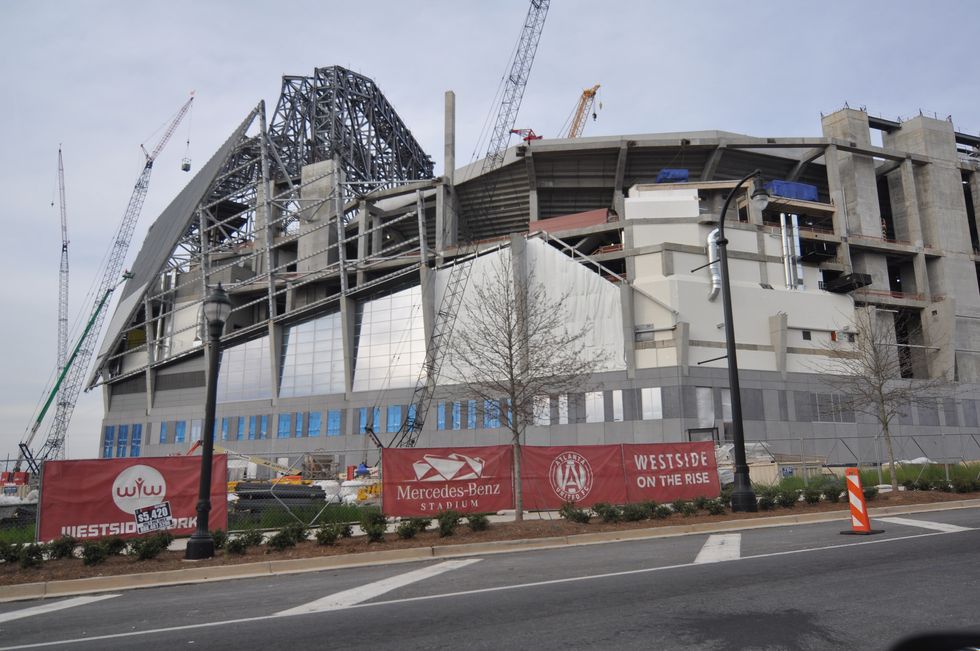The Mercedes-Benz stadium, which is due to be completed in the summer of 2017, will cost around 1.5 billion dollars to complete. 200 million of which will come from the City of Atlanta through the form of a hotel-motel tax. The stadium will host the home games of Atlanta’s football team and soccer team, the Atlanta Falcons and Atlanta United. The stadium will host a number of other sporting events as well, including the 2018 College Football Playoff National Championship, SEC Championship games from 2017 through 2027, and the 2019 Super Bowl. The stadium will be funded primarily by the billionaire Arthur Blank, the owner of both the Atlanta Falcons and Atlanta United.
The stadium will be outfitted with a retractable roof, a host of restaurants, the largest video board of any NFL stadium, and massive windows that overlook the city. In the shadow of this opulence lie some of Atlanta’s poorest neighborhoods, English Avenue and Vine City. When the development of stadiums is proposed one of the most frequently used arguments is that stadiums will increase the wealth and prosperity of those in the nearby area. However, as seen with the Georgia Dome and Turner Field these goals are not always achieved.
A number of things have plagued these neighborhoods through the years, contributing to its underdeveloped status. Firstly, the neighborhoods were cut off from the rest of the city by the development of federal highways in 1970 and the construction of the Georgia Dome in 1996 in preparation for the Olympics. These problems were then compounded by an out of date sewage system that couldn’t handle large amounts of rain, resulting in a number of houses being wiped out in flash floods. In addition to this the Georgia Dome never brought the prosperity it promised to bring to the area. While the stadium drew in large amounts of spectators, they rarely spent money at local businesses and restaurants. Even the businesses that did bring in money during home games did not profit significantly due to the relatively few amount of home games the Falcons played each season. Another oft used argument for the construction of new stadiums is that they will bring significant sporting events such as the Super Bowl to the city. The Georgia Dome hosted two Super Bowls, with each bringing an influx of tourists and money into the state. However, these injections of wealth proved to be short-term, and did not advance the long-term economic development of neighborhoods like Vine City and English Avenue.
Arthur Blank has proposed a different approach to economic development in these poverty-ridden neighborhoods. In addition to the money he is contributing the development of the stadium, the billionaire is also investing 20 million dollars into the surrounding neighborhoods. This money has been matched by Invest Atlanta and will help fund leadership programs in the area, a job-training center, new parks, and homes for police officers willing to live in the area. Arthur Blank also seeks to address the issue of flash floods by building a 68,000-gallon cistern to capture rainwater that would otherwise flood the neighborhoods. A number of companies partnered with Arthur Blank are also contributing to the development of the towns, such as SunTrust and IBM. SunTrust has introduced low-cost check cashing in the area while IBM has donated software to neighborhood non-profits. In terms of bringing business to the area the Mercedes-Benz stadium has another advantage of the Georgia Dome, the introduction of the new MLS franchise Atlanta United. The home games of Atlanta United will ensure that the stadium is drawing spectators year-round rather than just in football season.
Every time a stadium is built in a city it comes with the promise that it will spur economic development and revitalize the surrounding areas. In Atlanta’s case this has been far from the truth, with the areas around both the Georgia Dome and Turner Field remaining mired in poverty throughout the stadiums' lives. With the Mercedes-Benz Stadium there seems to be a concerted effort to mend the mistakes of the past. However, not everybody is convinced. Some say that the new stadium is unnecessary, and that if the city committed $200 million into the revitalization of the poverty-stricken areas instead then the problem could be dealt with more directly and efficiently. Others criticisms concern the issue of potential gentrification in neighborhoods around the stadium and the fact that long-term investments will be needed to lift the area out of poverty, not just one time deals. With these factors in mind, one couldn’t blame the residents of Vince City and English Avenue for being skeptical; it wouldn’t be the first time that they have been let down.









































